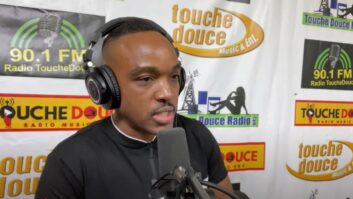Field Report: Presonus StudioLive 24.4.2
Mar 8, 2013 5:00 PM, By Chris Wygal, CBRE
For three decades Flames Sports Network Radio has broadcast Liberty University athletics to fans across Virginia. The network now includes a sizeable portion of North Carolina. As the football program has grown, so has the radio broadcast. The crew consists of eight on-air voices on game day. The road equipment rack has become very heavy. To tackle this problem the local pro audio shop suggested the Presonus StudioLive 24.4.2 digital mixer.

The digital mixer age has dictated that engineers let go of tradition. Huge equipment racks and heavy mixing surfaces are no longer required. It’s now all a function of DSP, which provides better usability and takes up much less room. Outboard processing is closer to your fingers than ever. Once delved into, digital mixing is not as foreign as it may seem.
The backfield and playing surface
On the rear of the StudioLive are familiar XLR or 1/4″ TRS input jacks and TRS insert points for each channel. The inputs are loaded with class-A preamplifiers. Aux and group outs are handled on 1/4″ TRS jacks. Main L/R outs are found on XLR or 1/4″ TRS jacks. The mono output uses XLR as well, and both L/R and mono have level adjustment knobs that will attenuate and boost levels from -80dB to +6dB. Control room outputs allow for studio monitoring and RCA jacks provide unbalanced tape ins and outs. The input for a talkback microphone is also on the back panel. A unique feature is a bank of three DB-25 connectors for efficient bundling of the 24 direct outs. Two FireWire ports allow for PC or Mac control and recording software integration. An S/PDIF jack allows for digital mains output. Two aux inputs live on 1/4″ TRS jacks.
The StudioLive boasts 100mm faders, knobs everywhere and illuminated, military grade quick-touch buttons. Twenty-four input faders have gain adjustment (-15dB attenuation to +65dB gain), solo and mute buttons. The four subgroups and mains are positioned at their normal spots. That however, is where the normal mixer layout stops. Now we’re back to the fact that the mixer is purely digital and it’s where live and studio sound hit pretty hard.
� Performance at a glance � � � Class A preamps on all input channels
� Fat Channel control of all inputs and outputs
� FireWire connectivity
� Store and Recall scenes for quick setup
� 100mm faders�
The StudioLive has a section at the top of the mixing surface for phantom power assignable to each input separately. The inputs can double as FireWire inputs when used with audio playback from a computer. Next down are the aux and effects sends. Each input channel can be assigned to any 10 of the aux outputs and either of the effects inputs. The aux outputs have level control knobs and can be set up for pre or post fader use and can be soloed to headphones and/or speakers. The effect sends can be muted. I use six aux sends for individual mixes to talent boxes, feed lines in the stadium and wireless equipment. I don’t use the DSP effects for football coverage; however, the built-in delay and reverb boast excellent pre-programmed acoustic effects. I have used the effects for live concert mixing and they are impressive. Plate reverb, tap effects and ping-pong delays are just a few from which to choose and create.
– continued on page 2
Field Report: Presonus StudioLive 24.4.2
Mar 8, 2013 5:00 PM, By Chris Wygal, CBRE
Introducing “The Fat Channel”
Next we come to the Fat Channel. Each input and output channel has a blue select button. When any select button is pressed, the Selected Channel display indicates what the Fat Channel will adjust. Essentially, Fat Channel is a single channel strip for all the inputs and outputs on the mixer. Hi-pass filter, phase, gate, compressor, hard limiter and four-band EQ settings for all inputs and outputs are controlled by the Fat Channel. Frequency, Q width and gain are available on each EQ section. Threshold, ratio, attack, release and gain are available in the compressor and gate sections. The Fat Channel also features key filtering.
Comparable to its digital mixer contemporaries, the Fat Channel eliminates the need for a full-featured channel strip on each input channel, but more importantly those same features can be applied to every output as well. For example, I use compression and hard limiting on the main output of the StudioLive before it goes down the line to the network studio. By pressing the select button above the mains fader, all the Fat Channel settings for the main output appear right at my fingertips. Levels for each Fat Channel parameter are displayed on 16-segment LED meters.
Fat Channel adjustments are made with knobs. If, for example, I choose to give the announcer on input channel 5 more compression, I press “select” on channel 5 and make the adjustments in the Fat Channel. Making the Fat Channel available on all inputs and outputs was a well-thought out plan. Imagine the amount of rack space necessary to add outboard processing to all those ins and outs.
Just below the Fat Channel are input channel assignment buttons. Pan, subgroup and mains tell each channel where to appear in the mix. Stereo link allows the user to pair up odd and even channel numbers, which assists in making changes stereo sources. And the copy, load and save buttons allow users to copy Fat Channel and assign settings to another channels, saving a good deal of time.
Storing and saving
The StudioLive features eight LED meters that indicate the selected channel input level, gain reduction and output levels for subgroups and mains. Below these meters is an LCD screen that deals with digital effects settings, and master control. Master control involves storing and recalling presets. This is handy for me each week. Instead of setting up the mixer and trying to get it exact each time, I can recall the scene for football games, and every setting pops right back into place. Below the master control screen are Aux Input A and B adjustments and settings, as well as sections for two-track tape in and out and headphone and monitor level adjustments and routing buttons. A mixture of tape, mains, soloed inputs and FireWire inputs can be sent to the headphone jack and control room output jacks. Talkback mic input attenuation and routing is also below the master control screen. The talkback mic is controlled by a latching talk button and can be routed to aux outputs 1-9 and mains.
� Presonus � � 225-216-7887
presonus.com
[email protected] �
One other great feature is the GEQ. Individual 31-band graphic equalizers can be turned on for the main outs, aux outs and subgroups. GEQ settings are controlled by the Fat Channel knobs.
Get on the bus and head home
I have barely touched on all the features packed into the PreSonus StudioLive mixers. The small-format layout and simple operation are hard-to-match attributes. Cursory knowledge of mixing consoles provides all the know-how needed to quickly become familiar with the StudioLive. Plus, its construction, non-existent noise floor and premium head amps make it hard to turn down when rough handling and pristine studio audio is in order. From the football field to the recording studio, StudioLive is nearly impossible to beat.
Wygal is the programmer and engineer for Victory FM at Liberty University, Lynchburg, VA.
March 2013
The 2013 NAB Show preview, streaming audio update, Sierra H updates its transmitter site, Field Reports on the Elenos ETG and Presonus StudioLive 24,4,2 and more….







